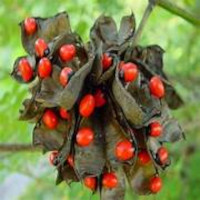Proximate, Mineral and Amino Acid Analysis of the Leaves of Abrus precatorius L. (Hitch) http://www.doi.org/10.26538/tjpps/v2i3.3
Main Article Content
Abstract
The plant Abrus precatorius is a wild edible flowering legume of the Fabaceae family. The leaves are used traditionally to treat ailments such as fever, skin cancer, typhoid, cough and hepatitis in Nigeria and some other countries. They are also utilized as vegetable and sweetener. A. precatorius leaves were analyzed for the proximate, mineral, amino acid and anti-nutritional composition using standard procedures. The proximate analysis revealed high amount of fibre (14.62%), crude protein (12.85%), moisture (6.55%) ash (6.34%), fat (4.95%) and carbohydrate (54.69%). A. precatorius leaves contain all the essential amino acids and compares favourably with standard requirement level of the FAO/WHO (1991). However, the values for leucine and lysine were below the WHO standard. The plant sample contains significant amount of magnesium, manganese, sodium, potassium, calcium and copper. The anti-nutrients composition of the leaves of A. precatorius was also determined. The leaves contain oxalate (7.92 mg/100g), phytate (16.20 mg/100g), trypsin inhibitors (6.15 mg/100g) but cyanide were not detected. Although, the amounts of mineral elements, essential amino acids and protein in this food/medicinal plant can boost immensely the diets of natives in Nigeria. Information from this research can provide valuable data to public health officials in the region with knowledge that will be beneficial in advising locals on the nutritional importance of A. precatorius leaves
Metrics
Article Details

This work is licensed under a Creative Commons Attribution-NonCommercial 4.0 International License.
References
Tressina, SP, Mohan, RV. Comparative Assessment on the Nutritional and Antinutritional Attributes of the Underutilized Legumes, Canavalia gladiate (JACQ.) DC, Erythrina indica LAM. And Abrus precatorius L. Trop Subtrop Agrosys. 2012; 15, 539-556.
Kakati, P, Deka, SC, Kotoki, D, Saikia, S. Effects of traditional methods of processing on the nutrient contents and some antinutritional factors in newly developed cultivars of green gram [Vigna radiata (L.) wilezek] and black gram [Vigna mungo (L.) Hopper] of Assam India. Intl. Fd. Res. J. 2010; 17, 377-384.
Tion, MT, Fotina, H, Saganuwan, SA. Phytochemical screening, proximate analysis, median lethal dose (LD50), hematological and biochemical effects of various extracts of Abrus precatorius seeds in Mus musculus. J. Adv. Vet. Anim. Res. 2018; 5(3): 354-360.
Pandey, M, Abidi, Ab, Singh, RP. Nutritional Evaluation of Leafy Vegetables Paratha. J. of Hum. Eco. 2006; 19(2): 155- 156.
Blandine, MKL, Ngangoum ES, Tchiégang C. Partial Purification and Characterization of Protease from Abrus precatorius Linn. (Fabaceae) from Cameroon. Adv. Enzy. Res., 2016; 4, 35-43.
Saganuwan, AS, Onyeyili, PA. Biochemical effects of aqueous leaf extract of Abrus precatorius (Jacquirity bean) in Swiss albino mice. Herbapol. 2010; 56(3), 63-80.
Association of Official An alytical Chemists (AOAC). Official Methods of Analysis of AOAC International, 17th edition; AOAC International 2015; Gaithersburg, MD, USA.
Onwuka, GI. Food Analysis and Instrumentation: Theory and Practice. Nephthalie prints, Surulere, Lagos, Nigeria. 2005, pp219-230.
Glew, HR, Kramer, GKJ, Hernandez, M, Pastuszyn, A, Jennifer, EJ, Djomdi, NN, Vanderjagt, JD. The Amino Acid, Mineral and Fatty Acid Contents of Three Species of Human Plants Foods in Cameroon. Fd. 2010; 4, 1- 6.
Penuel, BL, Khan, ME, Ibok, NU, Barminas, JT, Kefas, WS. Mineral, anti-nutrient and amino acid composition of Citrullus vulgaris (guna) seed protein concentrate. Int. J. Biotechnol. Food Sci. 2014; 2(7), 121-125.
World Health Organization (WHO)/Food and Agricultural Organization (FAO) Report: Energy and Protein Requirement. WHO Technical Report Series No. 724. World Health Organization. Geneva. (1985).
Gul, MZ, Farhan, A, Anand, KK, Insaf, AQ, Irfan, AG. Antioxidant and antiproliferative activities of Abrus precatorius leaf extracts - an in vitro study BMC Compl. Altern Med. 2013; 13:53.


